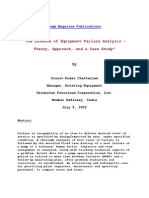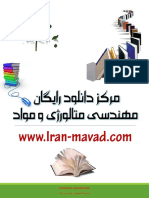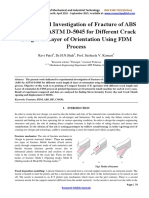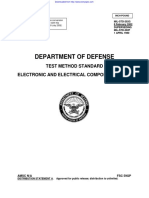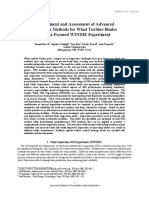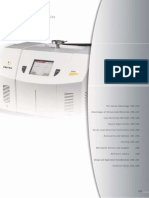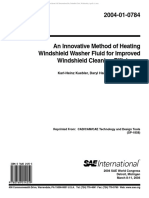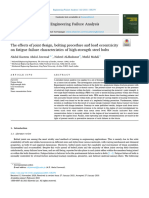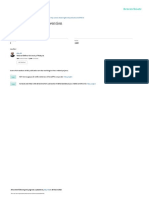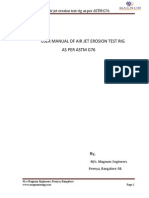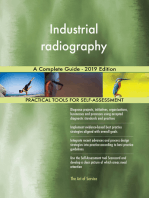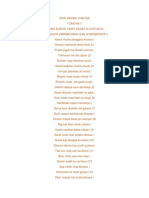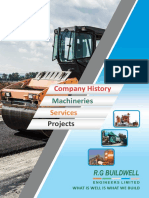Fatigue
Fatigue
Uploaded by
Nicolau MorarCopyright:
Available Formats
Fatigue
Fatigue
Uploaded by
Nicolau MorarCopyright
Available Formats
Share this document
Did you find this document useful?
Is this content inappropriate?
Copyright:
Available Formats
Fatigue
Fatigue
Uploaded by
Nicolau MorarCopyright:
Available Formats
1 | P a g e
Kingston University London
AEM111 - FURTHER AEROSPACE
STRUCTURES AND MATERIALS
EXPERIMENTAL NDT AND FATIGUE
ASSESSMENT FOR AIRCRAFT ALLOYS
Lecturer: Dr HOSSEIN MIRZAI
Submission: 31/05/2011
Author: Nicolau Iralal Morar
1 | P a g e
TABLE OF CONTENTS
INTRODUCTION .................................................................................................................. 2
1.1 FATIGUE TEST ...................................................................................................... 2
1.1.2 LOW CYCLE FATIGUE ......................................................................................... 3
1.1.3 HIGH CYCLE FATIGUE ........................................................................................ 3
1.1.4 METHOD OF CALCULATING FATIGUE STRENGTH .......................................... 4
1.2 NON-DESTRUCTIVE TESTING METHODS (NDT) ................................................ 5
2. EXPERIMENTAL APPROACH.......................................................................................... 6
2.1 SPECIMENS ............................................................................................................... 6
2.2 APPARATUS ............................................................................................................... 6
2.3. EXPERIMENTAL PROCEDURE ................................................................................ 7
2.4 RESULTS .................................................................................................................... 8
2.5 DISCUSSION ............................................................................................................ 10
3. NON-DESTRUCTIVE TESTING METHODS APPROACH .............................................. 15
3.1 MAGNETIC PARTICLE TEST APPROACH .............................................................. 15
Advantages ........................................................................ Error! Bookmark not defined.
Disadvantages .................................................................... Error! Bookmark not defined.
3.2 ULTRASONIC TEST APPROACH............................................................................. 18
3.3 DISCUSSION ............................................................................................................ 20
4. CONCLUSION ................................................................................................................ 24
REFERENCES ................................................................................................................... 25
APPENDIX A ...................................................................................................................... 26
TABLE OF RESULTS ......................................................................................................... 26
TABLE OF RESULTS Al 2011 T3 .................................................................................... 27
TABLE OF RESULTS Al 6082 T6 .................................................................................... 28
APPENDIX B ...................................................................................................................... 29
SPECIMEN PROPERTIES ................................................................................................. 29
2 | P a g e
INTRODUCTION
Aluminium alloys have been more and more extensively utilised in structural applications
and transportation industry for their light weight and attractive mechanical properties
achieved by thermal treatments. The objective of the present study report is to investigate
the performance of selected aerospace materials, in particular aluminium alloys. The first
objective is to carry out repeated fatigue tests for a range of amplitude stress levels to allow
comparison of results with experimental S-N data. An S-N curve is a suitable method of
establish fatigue endurance limit and life for structural materials. The data obtained is to be
used to establish endurance fatigue limit for such materials and to discuss their significance.
The aluminium alloys used in this study are Al2011 T3 and Al6082 T6. The second task of
the study is to perform the applicable methods of NDT used in the aircraft industry such as
ultrasonic and magnetic particle. Be able to understand the application and describe
methods and principles of operations concerned, as well as any advantages and
disadvantages of the methods used, observations and limitations and accuracy of methods
used.
1.1 FATIGUE TEST
A method for determining the behaviour of materials under fluctuating loads. A specified
mean load (which may be zero) and an alternating load are applied to a specimen and the
number of cycles required to produce failure (fatigue life) is recorded. Generally, the test is
repeated with identical specimens and various fluctuating loads. Loads may be applied
axially, in torsion, or in flexure. Depending on amplitude of the mean and cyclic load, net
stress in the specimen may be in one direction through the loading cycle, or may reverse
direction [1].
Data from fatigue testing often are presented in an S-N diagram which is a plot of the
number of cycles required to cause failure in a specimen against the amplitude of the
cyclical stress developed.
3 | P a g e
The cyclical stress represented may be stress amplitude, maximum stress or minimum
stress. Each curve in the diagram represents a constant mean stress. Most fatigue tests are
conducted in flexure, rotating beam, or vibratory type machines. The classical fatigue
experiments carried out by Wohler, method of reversing the stress on a part by employing a
cantilever rotated about its longitudinal axis. Hence the stress at any point on the surface of
the cantilever varied sinusoidal. In many applications, materials are subjected to vibrating or
oscillating forces. The behaviour of materials under such load conditions differs from the
behaviour under a static load. Because the material is subjected to repeated load cycles
(fatigue) in actual use, designers are faced with predicting fatigue life, which is defined as
the total number of cycles to failure under specified loading conditions. Fatigue testing gives
much better data to predict the in-service life of materials. Some typical materials that are
subjected to fatigue testing: Metals, Polymers, Composites, Elastomers, Structural
Components, Ceramics. The following ASTM standards apply to fatigue testing are: E1820,
E399, E606, E647 [2].
1.1.2 LOW CYCLE FATIGUE
Low Cycle Fatigue (LCF) describes the service environment of many critical (and primarily
metal) components: low frequency, large loads/strains. The LCF environment is typical of
turbine blades (heat-up/cool down cycling) and other power generation equipment subject to
thermal and/or mechanical cycling (ie. pressure vessels, piping, etc.) LCF typically involves
large deformations, thereby accumulating damage on the specimen. LCF research is
essential for the understanding of failure (in metals), for design and engineering purposes.
1.1.3 HIGH CYCLE FATIGUE
High Cycle Fatigue (HCF) results from vibratory stress cycles at frequencies which can
reach thousands of cycles per second and can be induced from various mechanical sources.
It is typical in aircraft gas turbine engines and has led to the premature failure of major
4 | P a g e
engine components (fans, compressors, turbines).While LCF involves bulk plasticity where
stress levels are usually above the yield strength of the material, HCF is predominantly
elastic, and stress levels are below the yield strength of the material [2].
Figure 1: Shows typical S-N diagram curve [2]
1.1.4 METHOD OF CALCULATING FATIGUE STRENGTH
To use graph (Fig. 1) to calculate fatigue strength, the material and the number of cycles is
required. The analytical method for estimating, S
f
(N) and S
e
, as follows:
a
f
N S
o
q
'
=
) (
(Equation 1)
The
5 | P a g e
1.2 NON-DESTRUCTIVE TESTING METHODS (NDT)
In the aerospace industry, as with other transportation industries, NDT is well- suited method
of identifying crack and damages in components or structures without eliminating and
destroying them. Aircraft components are inspected before they are assembled into the
aircraft and then they are periodically inspected throughout their useful life. Aircraft parts are
designed to be as light as possible while still performing their intended function.
This generally means that components carry very high loads relative to their material
strength and small flaws can cause a component to fail. Since aircraft are cycled (loaded
and unloaded) as they fly, land, taxi, and pressurize the cabin, many components are prone
to fatigue cracking after some length of time. The parts that are loaded well below the level
that causes them to deform can develop fatigue cracks after being cycled for a long time.
This is what happens in aircraft. After they are used for a while, fatigue cracks start growing
in some of their parts. Cracking can also occur due to other things like a lightning strike [3].
Common NDT methods include ultrasonic, magnetic particle, liquid penetrant, radiographic,
and eddy-current testing. Penetrant is used to check discontinuities i.e cracks, pits etc open
to the surface on parts made of non porous materials. This method depends on the ability of
the penetrant to enter into a surface discontinuity in the material to which it is applied. It is
applicable to all solid non-porous material. The NDT findings are a significant part of damage
tolerance analysis based on the fracture mechanics principles. The techniques for the
present study are magnetic particle and ultrasound techniques. Magnetic particle tests are
used to locate surface and sub-surface discontinuities in ferromagnetic material.
Ultrasonic tests depend on reflected sound effects to locate internal defects and it can be
used to measure the overall thickness of the material and the specific depth of a defect [4].
6 | P a g e
2. EXPERIMENTAL APPROACH
The equipment shows the classical fatigue experiments carried out by Wohler. Wohler
selected the method of reversing the stress on a part by employing a cantilever rotating
about its longitudinal axis [2]. This means that the stress at any point on the surface of the
cantilever varies sinusoidal. In the machine used at University laboratory the cantilever is
specially designed to use a relatively simple specimen with a definite minimum cross
section.
2.1 SPECIMENS
The specimens used for the experimental approach are Al 2011 T3 and Al 6082 T6. The
below figure 5 illustrates the specimen geometry and dimension references. The appendix B
provides the material composition and mechanical properties of the two specimens.
Figure 2: Specimen geometry
2.2 APPARATUS
Fatigue tester HSM .19 mk. 3 shown in Fig.6 is driven by an induction squirrel cage motor at
5700 rpm (95 Hz) with a counter ratio of 1:100. Power supply provided is 220V single
phase. The motor is connected on one side to a counter mechanism, which can record 5
digit revolution counter. Attached to the shaft at the other end is a fixture. The loading
device consists of a spherical ball bearing and a micro switch, which automatically switches
off the motor when the fracture occurs.
Figure 3: Fatigue tester apparatus (HSM .19 mk. 3)
7 | P a g e
The apparatus is supplied with a recommended standard specimen. The bending stress for
a load P (N) is:
|
.
|
\
|
=
2 3
32
mm
N
d
P L
t
o
Where: L = Distance from neck to specimens contact
point with bearing
d = Diameter of the neck
P = Load applied (measured by revolution counter read
out)
Figure 4: Counterbalance and load hanger
EXPERIMENTAL PROCEDURE
As fatigue fracture experiments may run on for half an hour or more so the usual procedure
is for each group in a class to set up and start two aluminium specimens and for all the
results to be shared at the end. The load sets was provided in the lab session, and
procedure as follows:
1. Measure the diameter at the neck of the specimen and inspect the surface
roughness.
2. Slide one end of the specimen into the adapter at the shaft end and slide the other
end into the adapter at the load end.
3. Measure the distance from the neck to the specimens contact surface with the
bearing. Now position the loading arm so that the dimension of 109.5 mm is attained
from the rear face of the bearing housing to the adjacent end of the neck of the
specimen (Fig. 7). Tighten the collect with the spanner.
4. Rotate the specimen to check that the end of the cantilever runs axially. If it does not
the specimen must have got bent and should be discarded.
8 | P a g e
5. Apply the given load. Check with the lab instructor about loading the specimen in
order to have a precise bending loading condition.
6. Set the revolution counter to zero and start the motor.
Results from other load cases will be collected and made available to each group
after all groups have completed the experiment.
7. Normally the test terminates itself through the fracture of the specimen opening the
micro switch and hence stopping the motor. As the onset of fracture approaches the
specimen will bend more and this may open the micro switch before complete
fracture occurs. In this case move the micro switch down slightly and restart the
motor.
8. Collate the results and plot them as they occur on a graph of stress range, o, against
log
l0
number of reversals N. Note that in the case of a rotating cantilever the stress
range is twice the applied bending stress.
2.4 RESULTS
The repetitive fatigue tests for various amplitude stress levels were conducted in the
laboratory at room temperature. The tests were performed for two aluminium alloy
specimens. The first test was run on an aluminium Al 2011 T3 alloy whilst the second test
was on an Al 6082 T6 alloy. The ultimate yield stress was taken into account to decided
what the maximum stress level applied be.
For the Al 2011 T3 the ultimate yield strength (UTS) is approximately referenced as 379
MPa which equates to 18.95 N. It was decided to use a maximum load of 18 N.
For the Al 6082 T6 the UTD is referenced to be 290 MPa, which equates to 14.5 N, hence
14 N was said to be the maximum load. The results are tabulated and displayed on the
appendix A for both specimens respectively.
The stresses were calculated using equation as follows:
(Eq.3)
Al 2011 T3
9 | P a g e
Load Stress Reading
No. Of
cycles (nc)
By:
5 100 No fail 4688300 Alex Wine
6 120 Fail 7753000 MS
7 140 Fail 236000 MS
8 160 Fail 338600 Alex Wine
9 180 Fail 85800 MS
10 200 Fail 84900 MS
11 220 Fail 32000 Alex Wine
12 240 Fail 30200 Group
13 260 Fail 27400 Group
15 300 Fail 9800 Group
16 320 Fail 3500 Group
18 360 Fail 2100 Group
18 360 Fail 1875 Group
Al 6082 T6
Load
Stress
(MPa)
No. Of
cycles(nc)
Reading By:
6 120 57889400 No fail MS
6.7 134 2411100 Fail Alex Wine
7 140 1526100 Fail MS
8 160 1028600 Fail MS
8.65 173 728400 Fail Alex Wine
9 180 263000 Fail MS
10 200 209700 Fail MS
10.6 212 114800 Fail Alex Wine
11 220 85500 Fail Group
11 220 72300 Fail Group
12 240 65300 Fail Group
12 240 49500 Fail Group
14 280 20100 Fail Group
14 280 16300 Fail Group
10 | P a g e
Figure 5: Al 2011 T3 S-N diagram curve
Figure 6: Al 6082 T6 S-N diagram curve
0
25
50
75
100
125
150
175
200
225
250
275
300
325
350
375
400
1.E+03 1.E+04 1.E+05 1.E+06 1.E+07 1.E+08
S
t
r
e
s
s
,
S
(
M
P
a
)
Number of Cycles ( N )
Al 2011 (T3)
Al 2011 T3 Experiment
50
75
100
125
150
175
200
225
250
275
300
1.E+04 1.E+05 1.E+06 1.E+07 1.E+08
S
t
r
e
s
s
,
S
(
M
P
a
)
Number of Cycles ( N )
Al 6082 (T6)
Al 6082 T6
Experiment(2011)
11 | P a g e
Figure 7: Al 2011 T3 S-N diagram curve comparison between 2010/11
Figure 8: Al 6082 T6 S-N diagram curve comparison between 2010/11
12 | P a g e
2.5 DISCUSSION
Fatigue testing was done to determine the effect of repeated stress variation on aluminium
alloy specimens for the present subject study. Since each specimen must be tested to failure
to obtain one piece of data, a number of specimens were used to complete one experiment
set. However, the number of tests was limited due to the malfunction of the test machine.
Only the high load and low cyclic frequencies were performed with maximum of number of
two tests being performed from the beginning. For the present study, data was gathered for
low cycles (14N to 8N load) from the experimental testing performed on the laboratory and
high cycles (7N to 6N load) were gathered from the current year student as he used for his
final year dissertation.
From the experiment, S-N diagrams were created from the data could be gathered with
regards to the stress variation of the aluminium alloys under the conditions of constant
amplitude stress.
The results and S-N diagram shows that at high stress intensities, the number of cycles to
failure were low, while the life expectancy of the sample increases with reduction of stress.
As mentioned previously, some of the fatigue data was collected from the fellow colleague
who had performed fatigue test for his dissertation prior to fatigue test machine break-down
as mentioned and referenced previously.
From the chart plotted, the endurance limit could be determined. For the case of non-ferrous
metals and alloys, such as aluminium, they do not reveal precise endurance limits. It can be
see that from the S-N diagram charts illustrated. The endurance limit represents a stress
level under which the material does not fail, hence can be cycled infinitely. If the applied
stress is below the endurance limit of the material then the material is assumed to have an
infinite life. The figure 5 and 6 illustrates that AL 2011 T3 and Al 6082 T6 specimens does
not have an endurance limit and has a continually decreasing S-N response. For such
cases, fatigue strength S
f
for a given number of cycles is specified.
13 | P a g e
The specified fatigue strength for the AL 2011 specimen is assumed to be at 120 MPa for
both years. From the selected specimens failure did not occur at a 6N load and number of
cycles at which this point is in the region of 1.11 x 10
7
cycles. This is known as the effective
endurance limit.
The AL 6082 T6 specimen has also been analysed for performance comparison purposes.
From figure 6, the effective endurance limit found to be 1.8 x 10
7
MPa for AL 6082 T6. Both
non failures occurred at a load of 6N. The load below at which there is an infinite life is 110
MPa in 2010 experiment and 105 MPa in 2011. With comparison with the AL 2011, the load
below which there would be an infinite life was taken as 120 MPa. The results show that the
Al 6082 composition performs better than the AL 2011. Although the loads at which this
specimen operates at is lower by 12.5%, of the two materials, it is better to use the AL 6082
as it has a better fatigue life, the AL 6082 performs better by 38%.
There were a maximum of two tests conducted for each load, and at each load both failures
and non-failures occurred. This may be due to the following reason: the surface roughness
causes microscopic stress concentrations which can lower fatigue strength.
- Grain size. The grain size has an impact on the fatigue life. Generally smaller
grain sizes yield longer life. The presence of surface defects or scratches will
also have a influence than in a coarse grained alloy
- Temperature. The temperature also a diverse effect on fatigue life as higher
temperatures generally decrease fatigue strength.
Compressive residual stresses from machining, cold working, heat treating will oppose a
tensile load and thus lower the amplitude of cyclic loading.
Because the system is hydraulically operated, it is possible to achieve both high loads and
high cyclic frequencies. The test system should be fitted with a control system that is
capable of controlling the test and measuring data at high frequencies. It is also important
14 | P a g e
that the load measurement system can accurately measure specimen load, and compensate
for load errors induced by the dynamic movement of the test system.
Accuracy depends upon three different factors: (1) the design of the machine :( 2) the use of
the machine and resulting wear in the bearings, seals and ; (3) the proper - manipulation of
the machine according to established instructions.
In the above-mentioned investigations which were carried out by means of electrical strain
gauges, deviations of the actual load from the nominal load of more than 30 to 40 per cent
were observed in some cases. When caused by uncorrected inertia forces, the accuracy
could lie substantially improved by applying correction factors as mentioned above, but in
some machines the errors resulted from the design of the machine or neglected
maintenance of its proper function. The latter objection applied particularly to hydraulic
machines.
15 | P a g e
3. NON-DESTRUCTIVE TESTING METHODS APPROACH
3.1 Magnetic Particle Inspection (MPI)
Method
When an object is magnetized, iron powder applied to the surface will accumulate over
regions where the magnetic field is disturbed as a result of surface flaws.
Application/advantages
MPI is a simple and fast method to detect surface defects in ferromagnetic materials.
Limitation
The MT is applicable only to ferromagnetic materials. It is for example not applicable to
stainless weld deposit on ferromagnetic base material. Trained operators are necessary to
avoid misinterpretations.
Principle
Figure 9: An Illustration of the Principle of Magnetic Particle Inspection [4]
Figure 10: An Illustration of Magnetic Particle Inspection [4]
16 | P a g e
Comments
Magnetic particle testing is used for locating surface or near surface discontinuities in
ferromagnetic materials. This method involves the establishment of a magnetic field within
the material to be tested. Discontinuities at or near the surface set up a disturbance in the
magnetic field. The pattern of discontinuities is revealed by applying magnetic particles to
the surface, either by dry powder or suspended in a liquid (wet method). The leakage field
attracts the magnetic particles, and thus the discontinuities may be located and evaluated by
observing the areas of particle build-up. These magnetically held particles form an indication
of the location, size and shape of the discontinuity. Some of the factors which determine the
detectability of discontinuities are the magnetizing current, the direction and density of the
magnetic flux, the method of magnetization and the material properties of the object to be
tested.
The electric current used to generate the magnetic field may be alternating (AC) or direct
(DC). The primary difference is that magnetic fields produced by DC are far more
penetrating than those produced by AC. Compared to liquid penetrant inspection, the MPI
has the following advantages: it will also reveal those discontinuities that are not surface open
cracks (cracks filled with carbon, slag or other contaminants) and therefore not detectable by
liquid penetrant.
Different nature of defects is detectable by the magnetic particle method such as cracks
caused by quenching, fatigue and embrittlement. Subsurface defects can also be detected
by this method of NDT however subsurface defects can only be located when they are
relatively close to the surface.
Prior to the application of magnetic particle method, the materials requires to be examined
that are capable of being magnetised at certain degree. There are several ways to
magnetise materials.
17 | P a g e
The most common methods are as follows:
Residual methods, the magnetism of the component is relied on when the magnetic
powder is applied.
Continuous methods in which the current inducing the magnetic flux in the part to be
inspected is allowed to flow while the power is applied.
The procedure used in university laboratory for the magnetic particle method us as follows
[3]:
1. Connect footswitch via socket on the left hand side of the unit.
2. Connect pump via the socket on the right hand side of the unit.
3. Connect the UV light to the UV light socket in the left hand side.
4. Turn Mains supply on at the wall isolator.
5. Switch on via RCD switch Unit on illuminates.
6. Turn on the UV light and allow 10 minutes to warm up.
7. Slide out the ink hopper to within 75 mm of the top flange with Fluorescent
Magnetic ink.
8. Slide in the Hopper gently
9. Turn on the agitation and dispensing pump using the twist switch on the right
hand of the machine.
10. With the inking out hose pointing to the drain tray, depress the ink applicator
button on the end of the hose to initially bleed the system.
18 | P a g e
3.2 ULTRASONIC TEST APPROACH
Method
Ultrasonic pulses are directed into a test object. Echoes and reflections indicate presence,
absence, and location of flaws, interfaces, and/or defects.
Application
Ultrasonic testing is a sensitive NDT-method, which can be used on metals or non-metals.
Best results are obtained when the sound beam is perpendicular to the defect. Defects may
be detected at depths ranging from 5 mm to 10 m in steel.
Limitations
Operation of ultrasonic equipment requires experienced personnel. False indications may
arise from multiple reflections and geometric complexity. Small and thin objects and coarse-
grained materials may be difficult to test. For example, welds involving nickel base alloys
and austenitic stainless steels tend to scatter and disperse the sound beam: penetration of
the sound beam into these materials is limited and interpretation of the results may be
difficult.
Principle
Figure 11: An Illustration of Ultrasonic Flaw Detection [4]
19 | P a g e
Comments
Ultrasonic methods of NDT use beams of sound waves (vibrations) of short wavelength and
high frequency, transmitted from a probe and detected by the same or other probes. Usually,
pulsed beams of ultrasound are used and in the simplest instruments a single probe, hand
held, is placed on the specimen surface. Ultrasonic energy is transmitted between the
search unit and the test part through a coupling medium such as oil, grease. An oscilloscope
display with a time base shows the time it takes for an ultrasonic pulse to travel to a reflector
(a flaw, the back surface or other free surface) in terms of distance travelled across the
oscilloscope screen. The height of the reflected pulse is related to the flaw size as seen from
the transmitter probe. The relationship of flaw size, distance and reflectivity are complex, and
a considerable skill is required to interpret the display [5].
Ultrasonic examinations are performed for the detection and sizing of internal defects, flaws
or discontinuities in piping, castings, forgings, weldments or other components. Exact sizing
techniques have been developed to detect and monitor progressive cracking in a variety of
equipment. Ultrasonic testing is often performed on steel and other metals and alloys,
though it can also be used on concrete, wood and composites, albeit with less resolution. It
is a form of non-destructive testing used in many industries including aerospace, automotive
and other transportation sectors [5].
Figure 12: Ultrasonic Sound Equipment [6]
20 | P a g e
When testing materials with ultrasound, two types of probes may be used; the normal probes
(0) (longitudinal waves) and the angle probes (transverse waves). The normal probe (0)
generates longitudinal waves and transmits them (via a couplant such as oil, grease or
water) into a test object in a direction normal to the surface to which the probe is applied.
The pulse propagates in a straight direction, but due to beam spread, the sound field will
become cone-shaped. The angle of beam spread is related to probe diameter and
frequency. In fig. 7.3 the principle of application of a normal probe is shown. The commonly
frequencies used are 2 MHz and 4MHz [6].
The angle probe is constructed to transmit transverse waves at a defined angle into a test
object. Typical angles are 35, 45, 60, 70and 80. The most commonly used angels are
45, 60, and 70. On materials with sound-velocities different from steel, the angle will
change according to Snells Law. For instance, a probe of 60 in steel will give 56 in
aluminium, 37in copper and 35in cast iron [6].
Procedure
Ultrasonic examination must be performed in accordance with a written procedure. In
general each procedure must include at least the following information, as applicable: Type
of instrument; Type of transducers; Frequencies; Calibration details; Surface requirements;
Type of couplants; Scanning techniques; Recording details; Reference to applicable welding
procedures
The following steps show describe how the ultrasonic scan should be conducted [3]:
1. Turn on the oscilloscope. Ensure the probe is connected correctly.
2. Lay the specimen to be examined on a flat surface.
3. Apply a film of oil on the components to be examined.
4. Gently run the crystal sensor over the top surface of the specimen. The readings
should be taken in parallel of the specimen.
5. Adjust the gain of the oscilloscope to provide a clear reading.
21 | P a g e
Figure 13:
Figure 14: Application of use for the crystal sensor
22 | P a g e
3.3 DISCUSSION
3.3.1 Magnetic particle Inspection
A number of factors can influence the production and quality of indications defect size depth
of defect below surface magnetising current level of magnetisation relative orientation of
defect and direction of magnetisation magnetic properties of test piece size and magnetic
properties of detecting the subject part.
The magnetised part that a uses dry method are pleasant to work compared to immersed by
the oil paste suspension, as are highly advantageous for large areas are to be inspected and
recovery of the oil-paste suspension would be hard. Also dry method (using powder) is
better for locating near-surface plate electrodes which make contact with the opposite
surfaces of a bench.
Also magnetic particle indications are formed directly on the surface of the part, shaping an
image of the discontinuity. This method is cost effective since the equipment costs are
relatively low. The main drawback is that only ferromagnetic materials can be inspected.
Also, requires alignment of magnetic field and defect is significant as they produce some
discrepancies.
Large currents are needed for very large parts and the surface has to be relatively smooth.
Non-magnetised coverings adversely affect the sensitivity plus, demagnetisation and post
cleaning is usually necessary.
Overall the orientation of the flaw with respect to the direction of the flow of magnetic flux
greatly influences the likelihood of creating a leakage field. Ideally the flaw should be at 90
to the flux flow, but detection may still be possible at 45. Components should be tested in at
least two directions to ensure maximum detection of flaws.
23 | P a g e
3.3.2 Ultrasound Test
Ultrasonic Inspection is a very useful and versatile NDT method. Some of the advantages of
ultrasonic inspection that are often cited include: It is sensitive to both surface and
subsurface discontinuities; the depth of penetration for flaw detection or measurement is
superior to other NDT methods; only single-sided access is needed when the pulse-echo
technique is used; It is highly accurate in determining reflector position and estimating size
and shape; minimal part preparation is required, electronic equipment provides
instantaneous results; detailed images can be produced with automated systems. It has
other uses, such as thickness measurement, in addition to flaw detection.
As with all NDT methods, ultrasonic inspection also has its limitations, which includes
surface must be accessible to transmit ultrasound, skill and training is more extensive than
with some other methods, It normally requires a coupling medium to promote the transfer of
sound energy into the test specimen, materials that are rough, irregular in shape, very small,
exceptionally thin or not homogeneous are difficult to inspect, cast iron and other coarse
grained materials are difficult to inspect due to low sound transmission and high signal noise,
linear defects oriented parallel to the sound beam may go undetected.
Possible errors may occur if thickness measurements are to be carried out on an object with
a coated surface; the coating may give rise to measurement errors. To avoid such errors
must use single crystal probes, and then measure the material thickness between first and
second echo. Also if using double crystal probes, the coating must be removed before
measurement is carried out.
Overall, for the effective results the calibration of the apparatus and probes are of decisive
importance. For the calibration of the equipment range scale and the angular determination
of angle probes, a calibration blocks are used.
24 | P a g e
4. CONCLUSION
25 | P a g e
REFERENCES
[1]
[2]
[3]
[4]http://www.ndt-ed.org/GeneralResources/MethodSummary/.htm
[accessed on 21/05/2011]
[5] http://engg-learning.blogspot.com/2011/03/non-destructive-techniques.html
[accessed on 21/05/2011]
[6] http://www.krautkramer.com/ [accessed on 21/05/2011]
[7] http://www.aalco.co.uk/.../Aalco-Metals-Ltd_Aluminium-Alloy_2011-T3_3.pdf.%20ashx
[accessed on 21/05/2011]
26 | P a g e
APPENDIX A
TABLE OF RESULTS
27 | P a g e
TABLE OF RESULTS Al 2011 T3
Table 1: Al 2011 T3 - 2011 Experimental Results
Load 18 18 18 16 16 16 14 14 14 16 16 16
Cycles 0000000 0000000 0000000 0000000 0000000 0000000 0000000 0000000 00000 0000000 0000000 0000000
Stress MPa)
Load 14 14 14 12 12 12 10 10 10 8 8 8
Cycles 0000000 0000000 0000000 0000000 0000000 0000000 0000000 0000000 00000 0000000 0000000 0000000
Stress MPa)
Source:
Table 2: Al 2011 T3 - 2010 Experimental Results
Load 18 18 18 16 16 16 14 14 14 16 16 16
Cycles 0000000 0000000 0000000 0000000 0000000 0000000 0000000 0000000 00000 0000000 0000000 0000000
Stress MPa)
Load 14 14 14 12 12 12 10 10 10 8 8 8
Cycles 0000000 0000000 0000000 0000000 0000000 0000000 0000000 0000000 00000 0000000 0000000 0000000
Stress MPa)
Source:
28 | P a g e
TABLE OF RESULTS Al 6082 T6
Table 3: Al 6082 T6 - 2011 Experimental Results
Load 18 18 18 16 16 16 14 14 14 16 16 16
Cycles 0000000 0000000 0000000 0000000 0000000 0000000 0000000 0000000 00000 0000000 0000000 0000000
Stress MPa)
Load 14 14 14 12 12 12 10 10 10 8 8 8
Cycles 0000000 0000000 0000000 0000000 0000000 0000000 0000000 0000000 00000 0000000 0000000 0000000
Stress MPa)
Source:
Table 4: Al 6082 T6 - 2011 Experimental Results
Load 18 18 18 16 16 16 14 14 14 16 16 16
Cycles 0000000 0000000 0000000 0000000 0000000 0000000 0000000 0000000 00000 0000000 0000000 0000000
Stress MPa)
Load 14 14 14 12 12 12 10 10 10 8 8 8
Cycles 0000000 0000000 0000000 0000000 0000000 0000000 0000000 0000000 00000 0000000 0000000 0000000
Stress MPa)
Source:
29 | P a g e
APPENDIX B
SPECIMEN PROPERTIES
30 | P a g e
Material Characteristics
2011 Aluminium T3
Al 2011 is the most machinable of the commonly available aluminium alloys. Machining
this alloy can produce excellent surface finishes on your product, and small, broken
chips.
Weld ability, strength, and anodizing response are all rated as average at best, and this
alloy does not have a high degree of corrosion resistance.
If the ability to make your part quickly is important to you, and strength is not the primary
desire, 2011 represents a good choice if you're using aluminium.
Temper: T3 - Solution heat treated, cold worked and naturally aged.
CHEMICAL COMPOSITION
Element %Present
Silicon (Si) 0.4 Typical
Iron (Fe) 0.7 Typical
Copper (Cu) 5 to 6
Lead (Pb) 0.2 to 0.6
Bismuth (Bi) 0.2 to 0.6
Zinc (Zn) 0.3 Typical
Others (Total) 0.15 Typical
Aluminium (Al) Balance
PHYSICAL PROPERTIES
Property Value
Density 2.82Kg/m
Melting Point 535C
Thermal Expansion 23x10-6/K
Modulus of Elasticity 71GPa
Thermal Expansion 138W/m.K
Electrical Resistivity 0.045x10-6 .m
MECHANICAL PROPERTIES
Property Value
Proof Stress 290-300 MPa
Ultimate Tensile Strength 379 MPa
Elongation 15%
Shear Strength 220 MPa
Hardness Vickers 110 HV
Table 5: Al 2011 T3 Characteristics
31 | P a g e
Material Characteristics
6082 Aluminium T6
You might also like
- Fatigue-Striation Counting MethodDocument8 pagesFatigue-Striation Counting MethodObeydullahKhanNo ratings yet
- 4.5 May2019-Repairable SystemDocument10 pages4.5 May2019-Repairable SystemAlexander GejetanusNo ratings yet
- The Effect of Fiber Architecture On The Mechanical Properties of Carbon-Carbon Fiber CompositesDocument13 pagesThe Effect of Fiber Architecture On The Mechanical Properties of Carbon-Carbon Fiber CompositesBolaji SuberuNo ratings yet
- Improvement of Central Soundness in Long Products From A Trough Process Control of Solidification and Reheating and RollingDocument153 pagesImprovement of Central Soundness in Long Products From A Trough Process Control of Solidification and Reheating and RollingOscar CelyNo ratings yet
- FFS MK7Document172 pagesFFS MK7DiNo ratings yet
- Article Failure AnalysisDocument25 pagesArticle Failure AnalysisMd KalamuddinNo ratings yet
- ECCC - RECOMMENDATIONS-2014-Vol6 - 2Document7 pagesECCC - RECOMMENDATIONS-2014-Vol6 - 2IndraNo ratings yet
- Advances in Fatigue and FractureDocument248 pagesAdvances in Fatigue and FractureBrandon EricksonNo ratings yet
- Creep TestDocument4 pagesCreep TestFerry Ferdiansyah50% (2)
- Carter Common Failures in Gas Turbine BladesDocument11 pagesCarter Common Failures in Gas Turbine BladesLeire MeigaNo ratings yet
- Fracture Mechanics 2Document16 pagesFracture Mechanics 2Jagannadha ReddyNo ratings yet
- Effect of Crack Orientation On Fracture Behaviour of Wire + ArcDocument9 pagesEffect of Crack Orientation On Fracture Behaviour of Wire + ArcviverefeliceNo ratings yet
- 2008 MATCOR Technical Bulletin - Deep Well Anode System Design FINALDocument10 pages2008 MATCOR Technical Bulletin - Deep Well Anode System Design FINALNWALLL100% (1)
- Chapter 06 Faa Corrosion PDFDocument44 pagesChapter 06 Faa Corrosion PDFluisegarfias100% (1)
- Crackwise 1Document5 pagesCrackwise 1Par Mad100% (1)
- Failure Analysis of Engineering MaterialsDocument2 pagesFailure Analysis of Engineering Materialsmahesh0% (1)
- Scanning Electron Microscope Fractography in Failure Analysis of Steels PDFDocument8 pagesScanning Electron Microscope Fractography in Failure Analysis of Steels PDFHolmer MorenoNo ratings yet
- Crackwise ArticleDocument8 pagesCrackwise ArticleYarko YurechkoNo ratings yet
- Circumferential Notched Tensile Testing For Correlation of The Stress Intensity Factor (KI) and Stress Corrosion Crack Growth RateDocument5 pagesCircumferential Notched Tensile Testing For Correlation of The Stress Intensity Factor (KI) and Stress Corrosion Crack Growth RateSinan ChenNo ratings yet
- Curve Determination: Standard Test Method ForDocument16 pagesCurve Determination: Standard Test Method ForNilton SantillanNo ratings yet
- Experimental Investigation of Fracture of ABS Material By-1647Document5 pagesExperimental Investigation of Fracture of ABS Material By-1647NoxNo ratings yet
- 32 Samss 008Document26 pages32 Samss 008naruto256100% (1)
- A Review of Failure Modes and Fracture Analysis of Aircraftcomposite MaterialsDocument13 pagesA Review of Failure Modes and Fracture Analysis of Aircraftcomposite MaterialsAndres Felipe Bello ZapataNo ratings yet
- 2006P Performance Reliability Analysis of Wind TurbinesDocument8 pages2006P Performance Reliability Analysis of Wind Turbinesdshalev8694No ratings yet
- Asme Section V B Se-1211Document6 pagesAsme Section V B Se-1211Monica SuarezNo ratings yet
- Fatigue Failure of An Idle Gear Shaft of A GearboxDocument9 pagesFatigue Failure of An Idle Gear Shaft of A GearboxGuilherme BandeiraNo ratings yet
- Fatigue Analysis of WeldDocument29 pagesFatigue Analysis of WeldBrandon AllenNo ratings yet
- Fatigue Performance of Sour Deepwater Riser WeldsDocument21 pagesFatigue Performance of Sour Deepwater Riser WeldsshervinyNo ratings yet
- SafetyConceptNEN3650 Guijtetal ISOPE2004Document10 pagesSafetyConceptNEN3650 Guijtetal ISOPE2004Jolien WillemsNo ratings yet
- Mil STD 202gDocument193 pagesMil STD 202gR&D SANPARNo ratings yet
- Metallographic Investigation On The Cladding FailureDocument18 pagesMetallographic Investigation On The Cladding FailureAndres_Pastor1987No ratings yet
- (Bolt Science) BOLTCALC Program Brochure PDFDocument3 pages(Bolt Science) BOLTCALC Program Brochure PDFAbdulrahman Al HuribyNo ratings yet
- Advanced Inspection Methods For Wind Turbine BladesDocument25 pagesAdvanced Inspection Methods For Wind Turbine BladesDagoberto AguilarNo ratings yet
- Failure Analysis of SA-213TP347H High-TemperatureDocument6 pagesFailure Analysis of SA-213TP347H High-TemperatureLakshminarayanNo ratings yet
- Fatigue Life Analysis of Aircraft Structural ComponentsDocument8 pagesFatigue Life Analysis of Aircraft Structural ComponentsSergey FedorinovNo ratings yet
- Varian Leak Detection BrochureDocument42 pagesVarian Leak Detection BrochureKarthikeyan SankarrajanNo ratings yet
- Pultrusion of Composites - An OverviewDocument15 pagesPultrusion of Composites - An OverviewAkhil DayaluNo ratings yet
- 2004-01-0784-An Innovative Method of Heating Windshield Washer Fluid For Improved Windshield Cleaning EfficiencyDocument11 pages2004-01-0784-An Innovative Method of Heating Windshield Washer Fluid For Improved Windshield Cleaning EfficiencyJicheng PiaoNo ratings yet
- The Effects of Joint Design, Bolting Procedure and Load Eccentricity On Fatigue Failure Characteristics of High-Strength Steel BoltsDocument22 pagesThe Effects of Joint Design, Bolting Procedure and Load Eccentricity On Fatigue Failure Characteristics of High-Strength Steel BoltsLucas InacioNo ratings yet
- Strathprints006351 PDFDocument86 pagesStrathprints006351 PDFJohann Barcelos100% (1)
- Fracture Mechanics Lecture 1Document62 pagesFracture Mechanics Lecture 1JamesNo ratings yet
- Condition Assessmen B&W Chap 45Document22 pagesCondition Assessmen B&W Chap 45Busairi AchmadNo ratings yet
- Project Fatigue PDFDocument219 pagesProject Fatigue PDFdudescapeNo ratings yet
- Bending Fatigue of Carburized SteelDocument9 pagesBending Fatigue of Carburized SteelChin-Min YangNo ratings yet
- ASTM A193 Bolting Materials For High Temperature ServiceDocument14 pagesASTM A193 Bolting Materials For High Temperature ServiceSilmina AdzhaniNo ratings yet
- Defstan 00 970Document323 pagesDefstan 00 970thomas duncan eelesNo ratings yet
- Fatigue Failure MATERIALSDocument37 pagesFatigue Failure MATERIALSfadjar sophianNo ratings yet
- Welding - Fissures DefectDocument12 pagesWelding - Fissures DefectthanhNo ratings yet
- NASA NSS 1740-15 - Safety STD O2 and O2 SystemsDocument116 pagesNASA NSS 1740-15 - Safety STD O2 and O2 SystemsNXVNNo ratings yet
- Evaluation of Failures in Mechanical Crankshafts of Automobile Based Onexpertopinion BDocument9 pagesEvaluation of Failures in Mechanical Crankshafts of Automobile Based Onexpertopinion BalanNo ratings yet
- Gear Tooth Rooth Fatigue Behaviour PDFDocument12 pagesGear Tooth Rooth Fatigue Behaviour PDFmr_bucixNo ratings yet
- 4-Failure Mode AnalysisDocument40 pages4-Failure Mode AnalysisAheza DesireNo ratings yet
- Air Jet ManualDocument35 pagesAir Jet ManualKumar Saheb100% (1)
- Thermo-Mechanical Processing and Forming of SteelsDocument14 pagesThermo-Mechanical Processing and Forming of SteelsParth AshokNo ratings yet
- Probabilistic Physics of Failure Approach to Reliability: Modeling, Accelerated Testing, Prognosis and Reliability AssessmentFrom EverandProbabilistic Physics of Failure Approach to Reliability: Modeling, Accelerated Testing, Prognosis and Reliability AssessmentNo ratings yet
- Hands-On Simulation Modeling with Python,: Develop simulation models for improved efficiency and precision in the decision-making processFrom EverandHands-On Simulation Modeling with Python,: Develop simulation models for improved efficiency and precision in the decision-making processNo ratings yet
- Ageing Management and Long Term Operation of Nuclear Power Plants: Data Management, Scope Setting, Plant Programmes and DocumentationFrom EverandAgeing Management and Long Term Operation of Nuclear Power Plants: Data Management, Scope Setting, Plant Programmes and DocumentationNo ratings yet
- Factors That Affect The Fatigue Strength of Power Transmission Shafting and Their Impact On DesignDocument29 pagesFactors That Affect The Fatigue Strength of Power Transmission Shafting and Their Impact On DesignDiscover With SAFFRON TIGERNo ratings yet
- Shri Vishnu ChalisaDocument7 pagesShri Vishnu ChalisaNicolau MorarNo ratings yet
- Hanuman Chalisa by TulsidasDocument5 pagesHanuman Chalisa by TulsidasNicolau MorarNo ratings yet
- GayatriDocument2 pagesGayatriNicolau Morar100% (1)
- Shree GaneshDocument5 pagesShree GaneshNicolau MorarNo ratings yet
- GanapatiDocument4 pagesGanapatiNicolau Morar100% (1)
- RevisingDocument3 pagesRevisingNicolau MorarNo ratings yet
- What Is Tie DyeDocument4 pagesWhat Is Tie DyeNicolau MorarNo ratings yet
- UAVW 15 BrochureDocument4 pagesUAVW 15 BrochureNicolau MorarNo ratings yet
- Kingston University: LondonDocument39 pagesKingston University: LondonNicolau MorarNo ratings yet
- Sunderkand PathDocument2 pagesSunderkand PathNicolau MorarNo ratings yet
- Chengdu Huari Communication Technology Co.,Ltd.: Speaker: Tang LinfengDocument28 pagesChengdu Huari Communication Technology Co.,Ltd.: Speaker: Tang LinfengDmitekNo ratings yet
- Consumo de Aceite InglesDocument2 pagesConsumo de Aceite InglesEfrain DennisNo ratings yet
- THE MEGA YEARBOOK 2017 - Curren - Disha Experts PDFDocument848 pagesTHE MEGA YEARBOOK 2017 - Curren - Disha Experts PDFDr. Firoze KhanNo ratings yet
- DIS-COT v2Document3 pagesDIS-COT v2lloyd ralphNo ratings yet
- Data Sheet PMB HDPE 242PDocument1 pageData Sheet PMB HDPE 242PAurum ChemicalsNo ratings yet
- Changes in Kenyan Business Environment in The Last 2 DecadesDocument5 pagesChanges in Kenyan Business Environment in The Last 2 DecadesButo12003100% (5)
- Basic Arithmetic and AlgebraDocument46 pagesBasic Arithmetic and AlgebraAyesha MudabirNo ratings yet
- Revised Guidelines For Contract EmploymentDocument28 pagesRevised Guidelines For Contract Employmentbridge14No ratings yet
- Quiz 11: This Is A Preview of The Published Version of The QuizDocument4 pagesQuiz 11: This Is A Preview of The Published Version of The QuizDeepesh YadavNo ratings yet
- Panel 1 - Brett Walker Roberts - Child Support Agency (English)Document26 pagesPanel 1 - Brett Walker Roberts - Child Support Agency (English)Mustafa KamalNo ratings yet
- Confidential ReportDocument15 pagesConfidential Reportapi-278578610No ratings yet
- Wework Membership Agreement: Contact InformationDocument11 pagesWework Membership Agreement: Contact InformationNelsonNo ratings yet
- LTE Handover Call FlowDocument11 pagesLTE Handover Call FlowDhiraj Singh100% (1)
- Data Flow DiagramDocument7 pagesData Flow Diagramahmed12588No ratings yet
- Annex V (Application) : - Unless Expressly Provided Otherwise, The Provisions of This Annex Shall Apply To All ShipsDocument71 pagesAnnex V (Application) : - Unless Expressly Provided Otherwise, The Provisions of This Annex Shall Apply To All ShipsAshutosh Kumar SinghNo ratings yet
- IIS Lecture 2Document27 pagesIIS Lecture 2Saad Mohamed SaadNo ratings yet
- RG Buildwell Profile Dec-18Document20 pagesRG Buildwell Profile Dec-18Akash KashyapNo ratings yet
- An Illustrated Guide To IPsecDocument19 pagesAn Illustrated Guide To IPsecwouterNo ratings yet
- Full Spelling For Literacy For Ages 10 11 Brodie Ebook All ChaptersDocument84 pagesFull Spelling For Literacy For Ages 10 11 Brodie Ebook All ChaptersyiingakyurtNo ratings yet
- 134 A - Flexible Hose SafetyDocument1 page134 A - Flexible Hose SafetyNibha100% (1)
- How Does A Pen Drive Work?: Young Explorer N February 2009 NDocument1 pageHow Does A Pen Drive Work?: Young Explorer N February 2009 NSaket BansalNo ratings yet
- Porosity Peameability RealationDocument22 pagesPorosity Peameability RealationStephen OcheNo ratings yet
- Spre I Zen TemplateDocument4 pagesSpre I Zen TemplatethiagarajanNo ratings yet
- Menu DesignDocument5 pagesMenu DesignMarven Mejares100% (2)
- Marketing Strategy of PepsiDocument6 pagesMarketing Strategy of Pepsisurbhi thakkarNo ratings yet
- The Marketing Mix - Borden - 12 ElementsDocument8 pagesThe Marketing Mix - Borden - 12 ElementsSASI KUMAR SUNDARA RAJANNo ratings yet
- Production Support ITILDocument24 pagesProduction Support ITILnaakheNo ratings yet
- Pro Clot PCDocument3 pagesPro Clot PCSmithesh TpNo ratings yet
- Department of Civil Engineering Curriculum & Syllabi R-2013 For B.E Civil Engineering Semester - I Course Code Course L T P C TheoryDocument50 pagesDepartment of Civil Engineering Curriculum & Syllabi R-2013 For B.E Civil Engineering Semester - I Course Code Course L T P C TheorygggNo ratings yet
- Sa 4Document3 pagesSa 4Khael Angelo Zheus JaclaNo ratings yet






